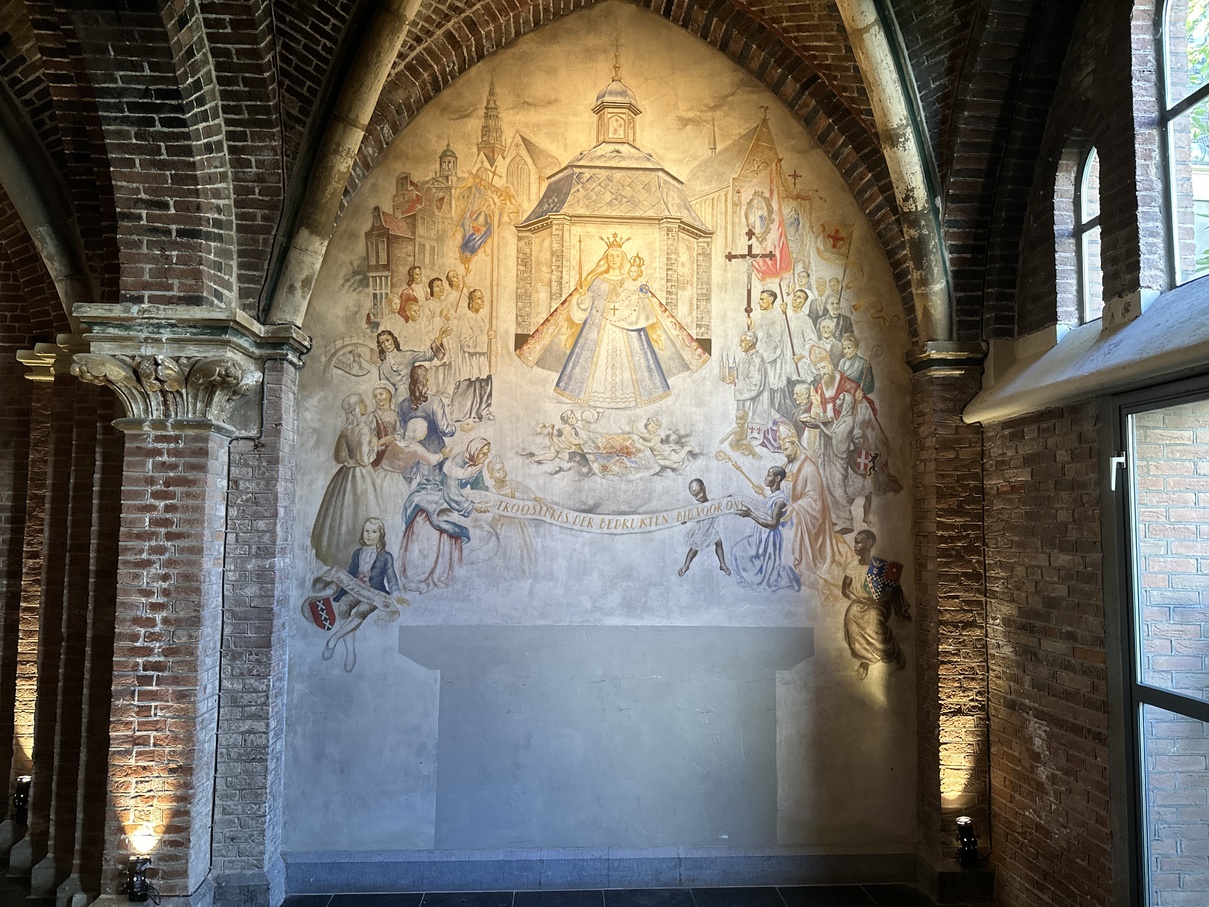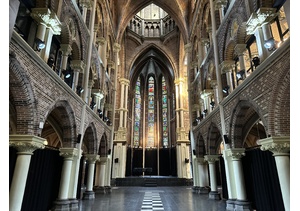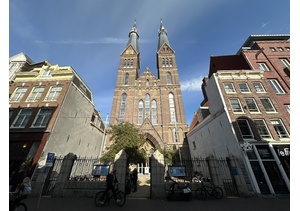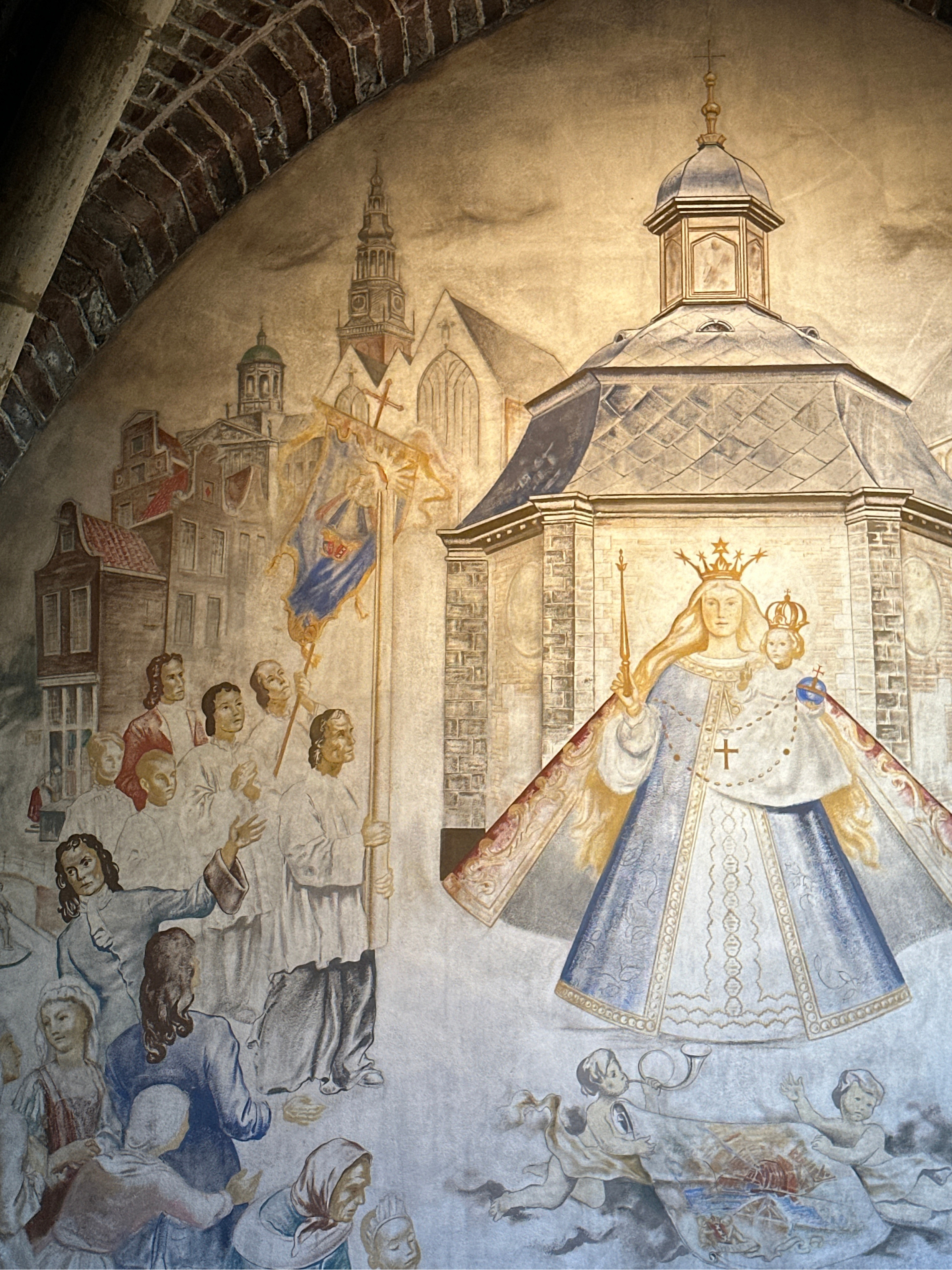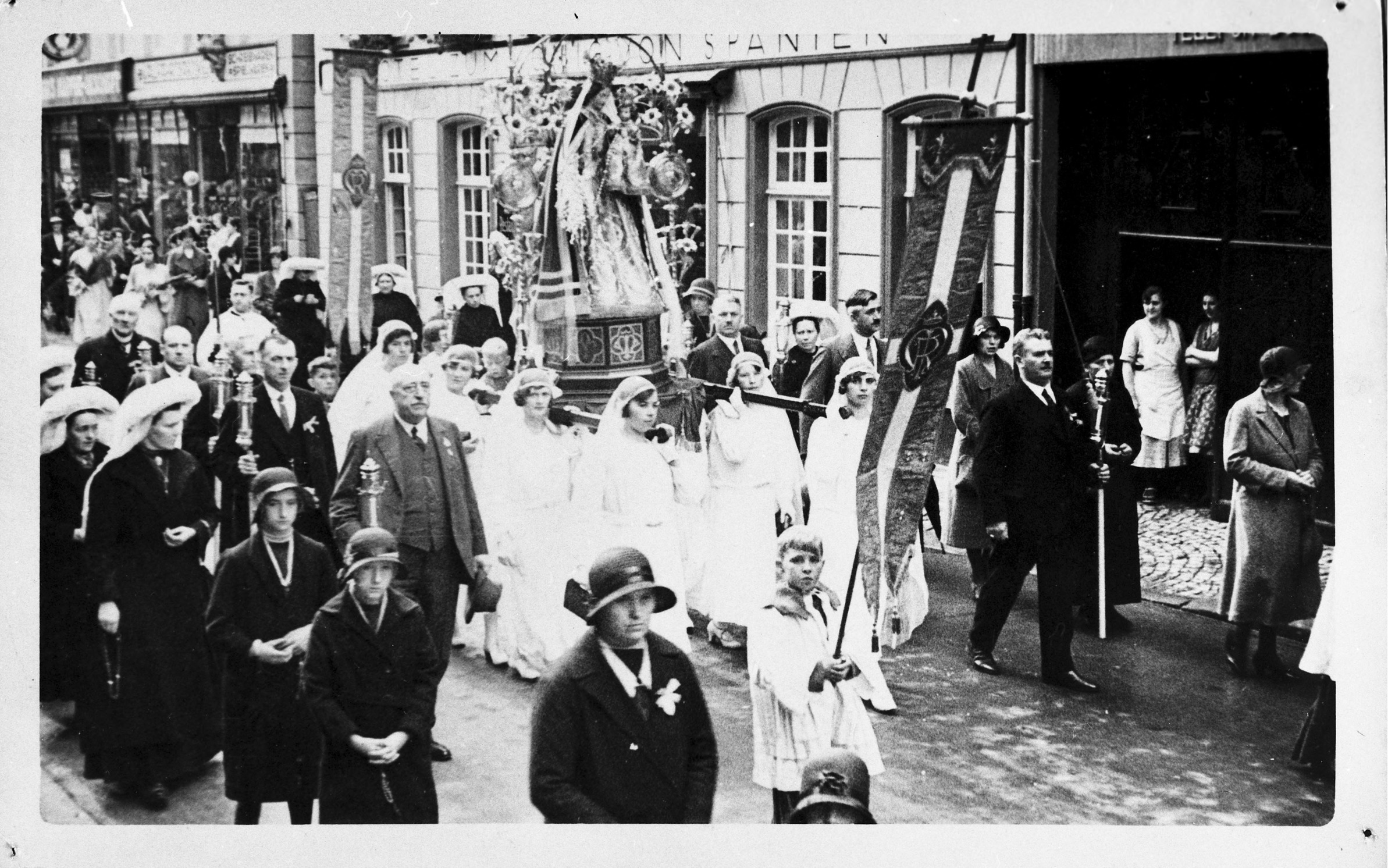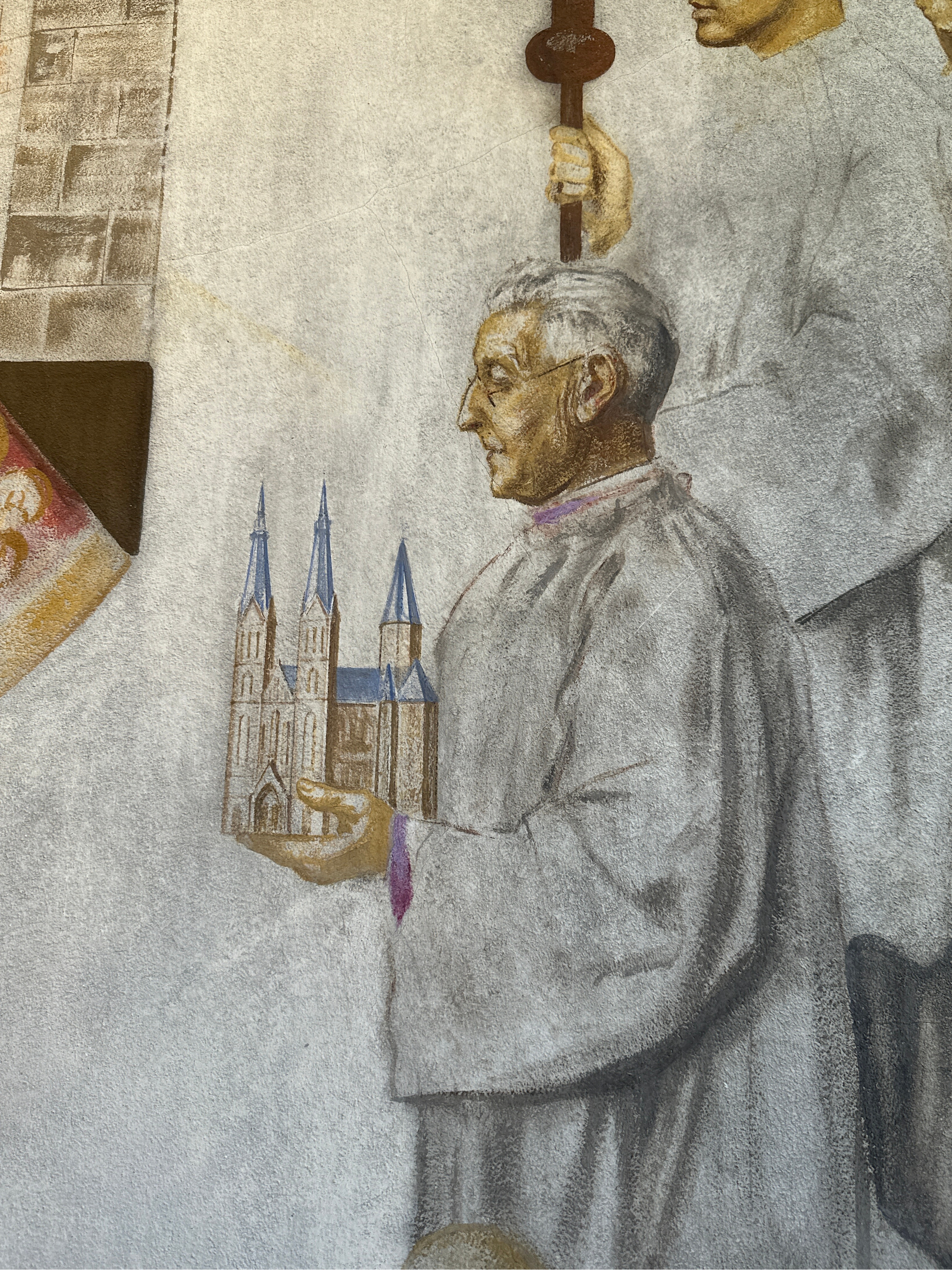When Amsterdam Catholics were no longer allowed to hold processions due to a nationwide prohibition, they had to go to a Marian shrine just across the border: Kevelaer. On a wall in the Posthoornkerk, which no longer functions as a church, this Amsterdam pilgrimage tradition to Kevelaer is depicted.
Location
Posthoorn Church (Church of Our Lady of the Immaculate Conception)
Haarlemmerstraat 124-126
Type
Church
Religious community
Roman Catholic Church
Object
A mural with pilgrims from Amsterdam in Kevelaer
Maker and date
Willem Schermer
1939
Visit
The Kevelaer Chapel is closed off during opening hours and cannot be visited
A souvenir of the pilgrims from Amsterdam.
In the Middle Ages, Amsterdam was a popular pilgrimage site thanks to the Miracle of Amsterdam. At the place where the miracle had occurred, the Heilige Stede (“Holy Site”) was built. This chapel served as Amsterdam’s most important shrine until the end of the sixteenth century. After the Alteration in 1578, the chapel was confiscated, then used as a horse stable, and later taken over by Protestants. To suppress its association with its earlier role as a Catholic pilgrimage chapel, they began calling the building the Nieuwezijds Chapel. Eventually, the church was demolished in 1908.
But this did not mean the end of the pilgrimage culture for the people of Amsterdam. In nearby Heiloo it continued, partly openly and partly in secret. There, devotion to Mary at the Runxput persisted after the Reformation, despite the demolition of the ruins of the old chapel by the Reformed authorities in 1637. Repeated prohibition measures issued by the States of Holland failed to curb the flow of pilgrims. Around 1750, the Amsterdammer Jan de Boer complained that the “fanatical Roman Catholics” did not limit their practices to Heiloo, but carried statues of saints and banners in procession already as far as Amsterdam.
Reformation
Movement in European Christianity that led to the emergence of the new church forms of Protestantism in the sixteenth century. The Reformation was largely determined by the thoughts and actions of Luther, Zwingli and Calvin.
Procession
Solemn circambulation of believers as an expression of veneration, joy or penance. A procession usually includes banners, statues of saints and the Blessed Sacrament in a monstrance. The faithful usually participate in the procession by singing and praying.
Heilige Stede
Literally ''holy place''. It refers to the location on Kalverstraat where the Miracle of Amsterdam took place in 1345. After the Protestant takeover in 1578, this church was also called Nieuwezijds Kapel. The original church that stood at this location was demolished in 1908 and was replaced by a new church building also called the Nieuwezijds Kapel.
Miracle of Amsterdam
The Miracle of Amsterdam took place in 1345 in a house on Kalverstraat. After a dying man could not keep down his last Holy Communion, a maid threw the vomit with the Blessed Host into the fireplace. The Host was found intact in the fireplace the next day. They concluded that God was present here in a special way and that He wanted to be worshipped in the Blessed Host at this location. Shortly afterwards, they built a pilgrimage chapel at the same location, which was called the Heilige Stede (Holy Place). This chapel was demolished in 1908.
Pilgrimage
Pilgrimage is traveling to a holy place. Sometimes the pilgrimage is undertaken on one’s own initiative; other times, it is the fulfillment of a religious duty. Pilgrims may travel to places where Jesus lived and worked, to reliquary shrines of certain saints, or to icons or statues to which a certain miraculous power was attributed. In the Middle Ages, there were already hundreds of such places in the Netherlands alone. The most important was Amsterdam, because of the Miracle of 1345.
Amsterdammers who wished to openly express their faith through processions had to turn to pilgrimage sites across the border, particularly Kevelaer in Germany. Since 1642, this town had been a center of Marian devotion surrounding a miraculous image, the so-called “picture of grace” of Our Lady, Comforter of the Afflicted. Located just 6 kilometers beyond the border, it became a popular destination for Dutch Catholics. In 1926, for instance, a train carrying 384 pilgrims departed from Amsterdam to Kevelaer, led by the pastor of the Posthoorn Church, Julianus Theodorus Lagerwey.
Pastor
(Latin for shepherd) is the priest, to whom the leadership of a parish (church) is entrusted by the bishop.
A reminder of this pilgrimage culture can still be seen in a chapel of the Posthoorn Church. Although the altar of the Kevelaer Chapel has disappeared, a wall painting from 1939 remains visible. On the wall, above the silhouette of the vanished altar, Mary of Kevelaer is depicted surrounded by Amsterdam pilgrims. The mural was created on the occasion of Pastor Lagerwey’s 50th priestly jubilee. He is shown on the right of the painting, holding the Posthoorn Church in his hands.
Although the Posthoorn Church is no longer used as a church, this mural still recalls the centuries-old struggle of Amsterdam’s Catholics to preserve traditional processions and pilgrimages.
Gert van Kleef
Board Member of the Cuypers Society (Het Cuypersgenootschap)
Last edited
October 16, 2025
The Kevelaer Chapel at the Posthoornkerk, Willem Schermer, 1939. Collection Posthoorn Church.
Interior and exterieur: photography Our Lord in the Attic Museum.
Detail: The Kevelaer Chapel at the Posthoornkerk, Willem Schermer, 1939. Collection Posthoorn Church.
Processie Kevelaer, vermoedelijk eind jaren '20, onbekende fotograaf, ca. 1920-1930. Collectie Harry van Liempd. Brabants Historisch Informatie Centrum.
Detail: The Kevelaer Chapel at the Posthoornkerk, Willem Schermer, 1939. Collection Posthoorn Church.
Lenarduzzi, Carolina, Katholiek in de Republiek. De Belevingswereld van een religieuze minderheid 1570-1750 (Nijmegen 2018).
Thiers, Ottie, 't Putje van Heiloo. Bedevaarten naar O.L. Vrouw Ter Nood (Hilversum 2005).
Wereld, Hans van der, Devotelyck naer Kevelaer (Soest 2012).
Online sources
Website van Stadsherstel locatie Posthoornkerk
Last visited 02-10-2025


